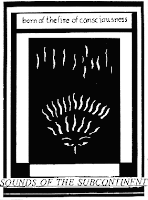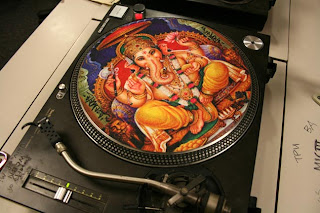Adhiraj Vable, a University of Michigan student, was one of the "Summer in South Asia" fellows of the Center for South Asian Studies in 2009. An Electrical Engineering major, he implemented a solar array to power a computer lab in a school in a village north of Bangalore. For this project he worked with community members to sustainably ensure that computer access is not limited during school hours due to electricity outages. This served as a pilot project of solar energy viability in rural southern India. I got to know Raj well in the last year and after he returned, we talked about the many aspects of his significant experiences in India. Here is a piece he wrote for this blog.
Growing up in the Upper Peninsula, I always thought of India as “that place my parents come from.” Our family was not very involved in the small Indian community in our area, and I didn’t feel any particular ties to my homeland – it was just that place that we’d go to every other summer. I would never have said I was proud to be an Indian, nor would I have said it embarrassed me; it just was one of many things I didn’t really understand, but didn’t feel any desire to explore.
Throughout my first few years in Ann Arbor, things pretty much stayed the same – I didn’t join any Indian centered student groups, and the Indians I was friends with were friends because of similar interests, not heritages. Again, my un-involvement in the Indian community was nothing fueled by resentment, it just wasn’t something that crossed my mind.
I think the tipping point in my interest in all things Indian came after my sophomore year of college, when I first read "Inward Revolution" by J. Krishnamurti. While both of my parents are spiritual people, our house is not a religious one and beyond a few visits to my friends’ churches, I never really dug into those thoughts. I first started reading Inward Revolution on the way to visit my grandparents’ house in Bangalore, and it was like wildfire in my mind. Everything I read completely gripped me, and I found many thoughts I thought were very personal being resonated in a book written over 50 years ago. Although Krishnamurti doesn’t advocate many things related to India, I very closely associate him with the country, because my grandfather is an avid reader of his works, and he is also Indian. Plus, the first time I read the book was while sitting on the steps of my grandparents’ house, so it was all tied together.
Two years later I began a project in my mother’s ancestral village that has grown into the focus of nearly all my time and effort. The project, Solar Power at Jnana Bodhini School, seeks to use solar power to drive a computer lab in the village’s school. The project was first supported by the Center for South Asian Studies here at UM, and it was through the CSAS that I was introduced to Ms. Sreyashi Dey.
When I went to the village to work on our project, one of the things I was keenly aware of was the spiritual atmosphere I was stepping into. Although I tried not to, I was definitely trying to “find myself” on my trip – in terms of cultural, family, and spirituality. I think that’s a pretty dangerous thing to do – to go looking for those types of connections – because I think genuine experiences are most authentic if they aren’t planned or expected. I knew I didn’t want to search for myself in going to India, and yet, part of me wanted to find that connection – my own inward revolution so I would understand the full depths of the things J. Krishnamurti described.
In my seven weeks there, I was surprised by how little that happened. I didn’t find myself rocked to the core or compelled to live like an ascetic. There was only one time when I was blown away by what I heard, and that was when I asked my grandfather (who meditates for eight hours everyday) about the relationship between science and god or whichever word you use to encapsulate the spiritual world. He said “Science points to god, and where science ends, god begins. But scientists will never find it with their instruments; god is too subtle.”
I chewed on that thought for a number of days following our conversation. And yet, I still didn’t find myself bowled over. I wanted to be, but when I was honest with myself, I wasn’t. I don’t know why. Maybe because I only get one chance at rapid spiritual development, or perhaps because the work we were doing at the school for the project was taking up most of my thoughts. Either way, for how much my grandfather’s sentence made me think, I was surprised at how little I found myself shook up.
However, while I didn’t gain much insight into my own spirituality, I did learn a lot about others’. Life in the village I was staying in was completely grounded in religion – the group of five guys I hung out with were extremely devout and never missed a trip to Temple; school was canceled because of religious functions; my grandmother lectured me on the prestige of our family temple, and the list goes on. The most complicated and pervasive example of religion was the caste system, a social hierarchical system that, as I understand it, says that you are born into a specific role in life. The caste system caused (and continues to cause) a lot of confusion for me, and I wrote about my impressions of it here: http://mblog.lib.umich.edu/~avable/archives/2009/07/first_impressio.html
It was very eye-opening to see a few of the results of having a highly religious and spiritual society. There were things I liked, and things I didn’t, but mostly things I didn’t fully understand. However, regardless of my opinion, the fact is that to do work in India is to do work in a religious environment. Developing an appreciation for that fact was important for my work in the village, and it’s interesting to note that developing an understanding of religion was beneficial to my work. It seems to me that everything is connected, and to talk about one aspect of society (i.e. religion) without thinking about the others is to miss the full picture. That’s an idea I’ve been working hard to remember, because it’s easy to slip into focusing on one thing without realizing that it is very influenced by externalities.
Right now, I’m 23 and gearing up for another trip to India this coming August. In preparing for the trip, I find myself asking the same questions as last time. How much will this trip change the way I view the world, myself, and myself in the world? Who will I be going in, and what will I be coming out? And how much will I even be able to gauge any amount of change? I don’t know what I’ll find, and chances are it won’t be what I thought. However, I know that to accomplish our work will require a deeper understanding of both my own beliefs, and of those of the villagers we are working with.
“To be yourself is very difficult, because you think that what you are is ignoble, and that if you could only change what you are into something noble it would be marvelous; but that never happens. Whereas, if you look at what you actually are and understand it, then in that very understanding there is a transformation. So freedom lies, not in trying to become something different, nor in following the authority of tradition, of your parents, of your guru, but in understanding what you are from moment to moment.” – J. Krishnamurti, from the book titled "Think on These Things"
Third grade girls reading at the Jnana Bodhini School. Photo: Raj Vable, 2009
Girls around the solar panel. Photo: Raj Vable, 2009




















 Photographs by Sreyashi Dey, May 2010
Photographs by Sreyashi Dey, May 2010

















